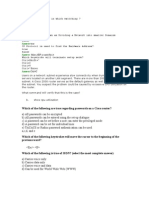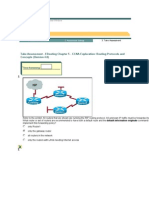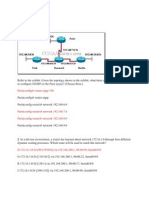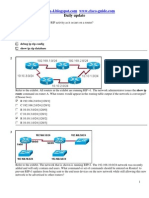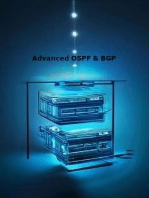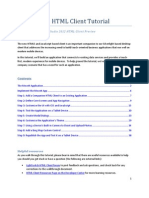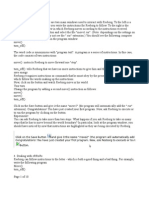ICND1 & ICND2 RIP Questions
ICND1 & ICND2 RIP Questions
Uploaded by
ruletriplexCopyright:
Available Formats
ICND1 & ICND2 RIP Questions
ICND1 & ICND2 RIP Questions
Uploaded by
ruletriplexOriginal Description:
Original Title
Copyright
Available Formats
Share this document
Did you find this document useful?
Is this content inappropriate?
Copyright:
Available Formats
ICND1 & ICND2 RIP Questions
ICND1 & ICND2 RIP Questions
Uploaded by
ruletriplexCopyright:
Available Formats
Type text to search here...
Home > RIP Questions
RIP Questions
July 15th, 2011 in ICND2 Go to comments Here you will find answers to RIP Questions
Note: If you are not sure about RIP, please read my RIP tutorial Question 1 What are two characteristics of RIPv2? (Choose two) A.classful routing protocol B. variable-length subnet masks C. broadcast addressing D. manual route summarization E. uses SPF algorithm to compute path
Answer: B D Question 2 Router_1# show ip protocols Routing Protocol is rip Sending updates every 30 seconds, next due in 8 seconds Invalid after 180 seconds, hold down 180, flushed after 240 Outgoing update filter list for all interfaces is not set Incoming update filter list for all interfaces is not set After a RIP route is marked invalid on Router_1, how much time will elapse before that route is removed from the routing table? A. 30 seconds B. 60 seconds C. 90 seconds D. 180 seconds E. 240 seconds
Answer: B Explanation The invalid and flush timers start at the same time and run concurrently. So after a RIP route is marked invalid, it will take 240 180 = 60 seconds for that route to be removed from the routing table. Question 3 Which three statements are correct about RIP version 2? (Choose three) A. It has the same maximum hop count as version 1. B. It uses broadcasts for its routing updates. C. It is a classless routing protocol. D. It has a lower default administrative distance than RIP version 1. E. It supports authentication. F. It does not send the subnet mask in updates.
Answer: A C E Question 4
HQ(config)# router rip HQ(config-router)# network 172.16.0.0 HQ(config-router)# exit HQ(conig)# ip route 172.16.15.0 255.255.255.0 172.16.18.2 150 Assuming that the routing protocol for the entire network is RIP, and the RIP is configured with its default settings. You properly configure all links and all these links are functioning normally. Regarding the network described which of the following statements are true? (Choose two) A. The HQ router will prefer to use its S0 interface to reach E1 of the Branch router. B. The HQ will prefer to use its BRIO interface to reach E1 on the Branch router. C. The HQ BRI0 interface will be used to reach the Branch E1 network in the event the S0 link fails. D. The HQ S0 interface will be used to reach the Branch E1 network in the event the BRI0 link fails.
Answer: A C Explanation The HQ router is configured with both static and RIP to reach 172.16.15.0/24 network so it has to use the Administrative Distance of each route to decide which route should it forward the packet to. The static route ip route 172.16.15.0 255.255.255.0 172.16.18.2 150 is configured with an AD of 150 but the default AD of RIP route is 120 so the RIP path will be favored over static route.
Question 5 Which statement about RIPng is true? A. RIPng allows for routes with up to 30 hops. B. RIPng is enabled on each interface separately. C. RIPng uses broadcasts to exchange routes. D. There can be only one RIPng process per router.
Answer: B Explanation The Routing Information Protocol next generation (RIPng) is an interior gateway protocol (IGP) that uses a distancevector algorithm to determine the best route to a destination, using the hop count as the metric. RIPng is a routing protocol that exchanges routing information used to compute routes and is intended for Internet Protocol version 6 (IPv6)-based networks. RIPng is enabled on each interface separately. Below is an example: R1(config)#ipv6 router rip 9tut //name the process RIPng 9tut R1(config-rtr)#exit R1(config)#interface E0/0 R1(config-if)#ipv6 rip 9tut enable //run RIPng 9tut process on E0/0 Question 6 A medium-sized company has a Class C IP address. It has two Cisco routers and one non-Cisco router. All three routers are using RIP version 1. The company network is using the block of 198.133.219.0/24. The company has decided it would be a good idea to split the network into three smaller subnets and create the option of conserving addresses with VLSM.
What is the best course of action if the company wants to have 40 hosts in each of the three subnets? A. Convert all the routers to EIGRP and use 198.133.219.32/27,198.133.219.64/27, and 198.133.219.92/27 as the new subnetworks. B. Maintain the use of RIP version 1 and use 198.133.219.32/27,198.133.219.64/27, and 198.133.219.92/27 as the new subnetworks. C. Convert all the routers to EIGRP and use 198.133.219.64/26,198.133.219.128/26, and 198.133.219.192/26 as the new subnetworks. D. Convert all the routers to RIP version 2 and use 198.133.219.64/26,198.133.219.128/26, and 198.133.219.192/26 as the new subnetworks. E. Convert all the routers to OSPF and use 198.133.219.16/28,198.133.219.32/28, and 198.133.219.48/28 as the new subnetworks. F. Convert all the routers to static routes and use 198.133.219.16/28,198.133.219.32/28, and 198.133.219.48/28 as the new subnetworks.
Answer: D Question 7
The network shown in the exhibit is running the RIPv2 routing protocol. The network has converged, and the routers in this network are functioning properly. The FastEthernet0/0 interface on R1 goes down. In which two ways will the routers in this network respond to this change? (Choose two) A. All routers will reference their topology database to determine if any backup routes to the 192.168.1.0 network are known. B. Routers R2 and R3 mark the route as inaccessible and will not accept any further routing updates from R1 until their hold-down timers expire. C. Because of the split-horizon rule, router R2 will be prevented from sending erroneous information to R1 about connectivity to the 192 168.1.0 network. D. When router R2 learns from R1 that the link to the 192.168.1.0 network has been lost, R2 will respond by sending a route back to R1 with an infinite metric to the 192.168.1.0 network. E. R1 will send LSAs to R2 and R3 informing them of this change, and then all routers will send periodic updates at an increased rate until the network again converges.
Answer: C D Question 8 What is the default routing update period for RIPv2?
A. 15 seconds B. 30 Seconds C. 180 Seconds D. 240 Seconds
Answer: B Question 9 What two things will a router do when running a distance vector routing protocol? (Choose two) A. Send periodic updates regardless of topology changes. B. Send entire routing table to all routers in the routing domain. C. Use the shortest-path algorithm to the determine best path. D. Update the routing table based on updates from their neighbors. E. Maintain the topology of the entire network in its database.
Answer: A D
Comments (51) Comments 1. ScottfromSouthAfrica May 18th, 2011 Q9:Why is option B not a valid answer? 2. BillyBob May 19th, 2011 Yes, why is B not a correct answer for Q9 3. NiggaPlz May 21st, 2011 I think this is a better explanation for question 2: 1. Router believes a network becomes unreachable. 2. Router simultaneously starts the invalid timer (180 seconds) and flush timer (240 seconds). 3. At the 180 second mark, the invalid timer expires and the router declares the route invalid. 4. An additional 60 seconds elapse. 5. At the 240 second mark, the flush timer expires and the router removes the route.
You might also like
- X-Ray Machine ManualDocument5 pagesX-Ray Machine ManualApayao Cagayan Medical Center Inc0% (1)
- Exam JN0-363: Service Provider Routing and Switching, Specialist (JNCIS-SP)Document43 pagesExam JN0-363: Service Provider Routing and Switching, Specialist (JNCIS-SP)Sehar100% (1)
- Dumps CCNP ENARSI 300-410: AnswerDocument22 pagesDumps CCNP ENARSI 300-410: AnsweryabrebenyNo ratings yet
- Artificial Neural Networks For Engineers and Scientists Solving Ordinary Differential EquationsDocument169 pagesArtificial Neural Networks For Engineers and Scientists Solving Ordinary Differential EquationsLeli GilmanNo ratings yet
- Presentation - CAN BusDocument31 pagesPresentation - CAN BusRajesh Prabhu100% (2)
- CCNA Sample QuestionsDocument12 pagesCCNA Sample Questionssujit mohanNo ratings yet
- When You Are Logged Into A Switch, Which Prompt Indicates That You Are in Privileged Mode? A. % B. at C. D. $Document29 pagesWhen You Are Logged Into A Switch, Which Prompt Indicates That You Are in Privileged Mode? A. % B. at C. D. $ĐinhĐạiĐồngNo ratings yet
- Answer:A & EDocument17 pagesAnswer:A & EArun ChandranNo ratings yet
- CCNP 300 410 ENARSI NetworkTUT 26 5 2021Document104 pagesCCNP 300 410 ENARSI NetworkTUT 26 5 2021Olga BradyNo ratings yet
- Ccna HCL Exam QuestionsDocument25 pagesCcna HCL Exam Questionsshyam80No ratings yet
- Cisco CCNA Exploration V 4.0, Module 2, Chapter 5 ExamDocument7 pagesCisco CCNA Exploration V 4.0, Module 2, Chapter 5 ExamAdryana EnacheNo ratings yet
- Answer: Which of The Following Are True Regarding Passwords On A Cisco Router?Document37 pagesAnswer: Which of The Following Are True Regarding Passwords On A Cisco Router?dijeshkelothNo ratings yet
- CCNA 2 Chapter 5 V4.0 Answers: Admin Leave A CommentDocument9 pagesCCNA 2 Chapter 5 V4.0 Answers: Admin Leave A Commentsathesh005No ratings yet
- Ccna Sample QuestionDocument25 pagesCcna Sample Questionwarrior_dil997No ratings yet
- CCNA 2 Final Exam V4.0 AnswersDocument13 pagesCCNA 2 Final Exam V4.0 Answers0MarcM0No ratings yet
- Answer:A & EDocument15 pagesAnswer:A & ELvenkatesh VenkateshNo ratings yet
- Cisco CCNA II Take AssessmentsDocument26 pagesCisco CCNA II Take AssessmentsNina VučetićNo ratings yet
- Answer:A & EDocument13 pagesAnswer:A & EkingmibNo ratings yet
- Assessment System: Take Assessment - Erouting Chapter 5 - Ccna Exploration: Routing Protocols and Concepts (Version 4.0)Document8 pagesAssessment System: Take Assessment - Erouting Chapter 5 - Ccna Exploration: Routing Protocols and Concepts (Version 4.0)asdasdasd123456No ratings yet
- CCNA 2 Chapter 7 v5.0 Exam Answers 2015 100Document7 pagesCCNA 2 Chapter 7 v5.0 Exam Answers 2015 100ovidiu0702No ratings yet
- CCNA QuestionsDocument23 pagesCCNA QuestionsMangesh KakadeNo ratings yet
- Router: Router1 (Config-Router) # Passive-Interface Fastethernet 0/0Document13 pagesRouter: Router1 (Config-Router) # Passive-Interface Fastethernet 0/0copley50No ratings yet
- Take Assessment - Erouting Chapter 5 - Ccna Exploration: Routing Protocols and Concepts (Version 4.0) - Answers - 2012 - 2013Document8 pagesTake Assessment - Erouting Chapter 5 - Ccna Exploration: Routing Protocols and Concepts (Version 4.0) - Answers - 2012 - 2013Dzevad MakotaNo ratings yet
- CCNA2 Final Mar 2010: CCNA Cisco Routing Protocols and Concepts Final Exam PracticeDocument21 pagesCCNA2 Final Mar 2010: CCNA Cisco Routing Protocols and Concepts Final Exam Practicetuananh0788No ratings yet
- CCNA 2 Final Exam V4Document13 pagesCCNA 2 Final Exam V4Ale AlvarezNo ratings yet
- FinalDocument13 pagesFinallambobNo ratings yet
- CCNA 2 Final Exam AnswersDocument29 pagesCCNA 2 Final Exam Answerslollypopd79No ratings yet
- Ccie QuestionsDocument123 pagesCcie Questionsnwytg48No ratings yet
- Test 22 Ccna1 Ccna2 AcadnetDocument20 pagesTest 22 Ccna1 Ccna2 AcadnetdanmNo ratings yet
- CCNA 2 Final Exam V4 PDFDocument63 pagesCCNA 2 Final Exam V4 PDFkowalski_jan69No ratings yet
- Final CCNA2 4Document27 pagesFinal CCNA2 4itborgNo ratings yet
- CCNA 2 Chapter 6 v5.0 Exam Answers 2015 100Document8 pagesCCNA 2 Chapter 6 v5.0 Exam Answers 2015 100ovidiu0702No ratings yet
- CCNA Exploration2: Routing Protocols and Concepts - Final ExamDocument12 pagesCCNA Exploration2: Routing Protocols and Concepts - Final ExamSumi SultanaNo ratings yet
- 6.4.3.3 Packet Tracer - Connect A Router To A LAN - InstructionsDocument5 pages6.4.3.3 Packet Tracer - Connect A Router To A LAN - InstructionsLaura HampNo ratings yet
- Ip RoutingDocument19 pagesIp RoutingMaria AlvaradoNo ratings yet
- Lab 07 RIP ConfigurationDocument12 pagesLab 07 RIP Configurationmuhammad.mursleen025No ratings yet
- Ccna2 Chapter 5Document9 pagesCcna2 Chapter 5dvemic34No ratings yet
- Ccna 2 Final ExamDocument22 pagesCcna 2 Final ExamchiritaaalexNo ratings yet
- SET A FinalDocument5 pagesSET A Finaladhe laishramNo ratings yet
- CCNA 2 Final Exam Question Ans AnswerDocument100 pagesCCNA 2 Final Exam Question Ans AnswerTú BéoNo ratings yet
- h12 221 EnuDocument8 pagesh12 221 EnuSAJJANNo ratings yet
- CCNA Exploration 4.0 ERouting Final Exam 59 Questions 100%Document22 pagesCCNA Exploration 4.0 ERouting Final Exam 59 Questions 100%Fuuton Ransenshuriken100% (3)
- 640-802 SampleDocument14 pages640-802 SampleSam SheenNo ratings yet
- CCNA Exploration 2: Module Final Exam Answers 3Document8 pagesCCNA Exploration 2: Module Final Exam Answers 3Peter PoelmansNo ratings yet
- 6.4.3.3 Packet Tracer - Connect A Router To A LANDocument5 pages6.4.3.3 Packet Tracer - Connect A Router To A LANSergio MonteNo ratings yet
- CCNA 2 - Final Exam AnswersDocument24 pagesCCNA 2 - Final Exam AnswersNguyễn Duy TrángNo ratings yet
- 6.4.3.3 Packet Tracer - Connect A Router To A LANDocument5 pages6.4.3.3 Packet Tracer - Connect A Router To A LANAzeemuddin MohammedNo ratings yet
- Mtcre Koleksi Hasan MGMP TKJDocument33 pagesMtcre Koleksi Hasan MGMP TKJNarcis KoemannNo ratings yet
- Mtcre Koleksi Hasan MGMP TKJDocument33 pagesMtcre Koleksi Hasan MGMP TKJUjang Dian100% (1)
- 100% Correct: Erouting Final Exam - Ccna Exploration: Routing Protocols and Concepts (Version 4.0)Document19 pages100% Correct: Erouting Final Exam - Ccna Exploration: Routing Protocols and Concepts (Version 4.0)Rodrigo DominguesNo ratings yet
- ROUTING INFORMATION PROTOCOL: RIP DYNAMIC ROUTING LAB CONFIGURATIONFrom EverandROUTING INFORMATION PROTOCOL: RIP DYNAMIC ROUTING LAB CONFIGURATIONNo ratings yet
- CISCO PACKET TRACER LABS: Best practice of configuring or troubleshooting NetworkFrom EverandCISCO PACKET TRACER LABS: Best practice of configuring or troubleshooting NetworkNo ratings yet
- Fundamentals of Network Planning and Optimisation 2G/3G/4G: Evolution to 5GFrom EverandFundamentals of Network Planning and Optimisation 2G/3G/4G: Evolution to 5GNo ratings yet
- LEARN MPLS FROM SCRATCH PART-B: A Beginners guide to next level of networkingFrom EverandLEARN MPLS FROM SCRATCH PART-B: A Beginners guide to next level of networkingNo ratings yet
- Exploring BeagleBone: Tools and Techniques for Building with Embedded LinuxFrom EverandExploring BeagleBone: Tools and Techniques for Building with Embedded LinuxRating: 4 out of 5 stars4/5 (2)
- Knowledge Assessment Answers 5Document9 pagesKnowledge Assessment Answers 5ruletriplexNo ratings yet
- Knowledge Assessment Answers 8Document4 pagesKnowledge Assessment Answers 8ruletriplexNo ratings yet
- Knowledge Assessment Answers 7Document4 pagesKnowledge Assessment Answers 7ruletriplex100% (1)
- Knowledge Assessment Answers 6Document4 pagesKnowledge Assessment Answers 6ruletriplexNo ratings yet
- Setting Up 802.1x AuthentiactionDocument4 pagesSetting Up 802.1x AuthentiactionruletriplexNo ratings yet
- Knowledge Assessment Answers 1Document3 pagesKnowledge Assessment Answers 1ruletriplex100% (2)
- DHCP Step by Step GuideDocument28 pagesDHCP Step by Step GuideruletriplexNo ratings yet
- LightSwitch HTML Client TutorialDocument39 pagesLightSwitch HTML Client TutorialruletriplexNo ratings yet
- Knowledge Assessment Answers 4Document4 pagesKnowledge Assessment Answers 4ruletriplexNo ratings yet
- RRAS TutorialDocument10 pagesRRAS TutorialruletriplexNo ratings yet
- HW Solution Chap1-3Document8 pagesHW Solution Chap1-3ruletriplexNo ratings yet
- PowerShell TutorialDocument17 pagesPowerShell TutorialruletriplexNo ratings yet
- Lab13 WorksheetDocument4 pagesLab13 WorksheetruletriplexNo ratings yet
- Lab13 WorksheetDocument4 pagesLab13 WorksheetruletriplexNo ratings yet
- Lab11 WorksheetDocument5 pagesLab11 WorksheetruletriplexNo ratings yet
- Rambam: Tekhelet Tying Detailed InstructionDocument12 pagesRambam: Tekhelet Tying Detailed Instructionapi-85444408100% (1)
- Problematic Mobile Phone Use in Adolescents: Derivation of A Short Scale MPPUS-10Document24 pagesProblematic Mobile Phone Use in Adolescents: Derivation of A Short Scale MPPUS-10Laura GarciaNo ratings yet
- JEE Opening and Closing Ranks - MECHANICAL - IITDocument14 pagesJEE Opening and Closing Ranks - MECHANICAL - IITdrjwalitmehtaNo ratings yet
- Anatolyev ProblemnikDocument116 pagesAnatolyev ProblemnikJosé Miguel Carrasco100% (1)
- Langston Charter Middle School ReportDocument155 pagesLangston Charter Middle School ReportjorierdmanNo ratings yet
- 9 The Post Anesthesia Care UnitDocument77 pages9 The Post Anesthesia Care Unitsanjivdas100% (1)
- Qualitative Treatment of Molecular Orbital TheoryDocument27 pagesQualitative Treatment of Molecular Orbital TheoryIfiok Usoro100% (1)
- Individual Cognitive Behavioral Therapy and Combined Family/individual Therapy For Young Adults With Anorexia Nervosa: A Randomized Controlled TrialDocument16 pagesIndividual Cognitive Behavioral Therapy and Combined Family/individual Therapy For Young Adults With Anorexia Nervosa: A Randomized Controlled TrialAggelou MayaNo ratings yet
- Burger King Vegetable Preparation 123456789Document12 pagesBurger King Vegetable Preparation 123456789ScribdTranslationsNo ratings yet
- Week 8Document17 pagesWeek 8HikariMujiNo ratings yet
- SE - Unit 4 and 5 - CompleteDocument35 pagesSE - Unit 4 and 5 - Completeaishwarya mekalaNo ratings yet
- Uno GawainDocument5 pagesUno GawainKimberly Jeph TagleNo ratings yet
- Integrated Quality ManagementDocument8 pagesIntegrated Quality Managementselinasimpson2401No ratings yet
- Apreb/ Poster Spa 3 - BriseDocument1 pageApreb/ Poster Spa 3 - Briseannie 239No ratings yet
- Notification BOB Specialist Officer PostsDocument2 pagesNotification BOB Specialist Officer PostsHemanth Kumar TanguturiNo ratings yet
- The London Polonium Poisoning Events & Medical ImplicationsDocument5 pagesThe London Polonium Poisoning Events & Medical ImplicationsGroze BogdanNo ratings yet
- Internal Communication HandBookDocument19 pagesInternal Communication HandBookAIESECPereiraNo ratings yet
- Rurple ManDocument10 pagesRurple ManJusto LuxNo ratings yet
- Sarah M. Espe BSSDocument3 pagesSarah M. Espe BSSxxpaperodlssxxNo ratings yet
- Quiz Economics MeetDocument22 pagesQuiz Economics MeetMeet AhirNo ratings yet
- From Powders To Thermally Sprayed CoatingsDocument25 pagesFrom Powders To Thermally Sprayed CoatingsRoberson SilvaNo ratings yet
- 1W1b. Introduction To GrammarDocument9 pages1W1b. Introduction To GrammarPriscilla RonnyNo ratings yet
- Carrying Capacity Assessment For SustainDocument41 pagesCarrying Capacity Assessment For SustainShanto Chowdhury100% (2)
- Dan-Resume-Aug-2021 1Document1 pageDan-Resume-Aug-2021 1api-337913388No ratings yet
- FalloutDocument27 pagesFalloutPedro Felipe Moreno CarvajalNo ratings yet
- 1 s2.0 S1991790222000307 MainDocument2 pages1 s2.0 S1991790222000307 Maingfdsa jklNo ratings yet
- Capsman MikrotikDocument37 pagesCapsman MikrotikMehdi GrimNo ratings yet











